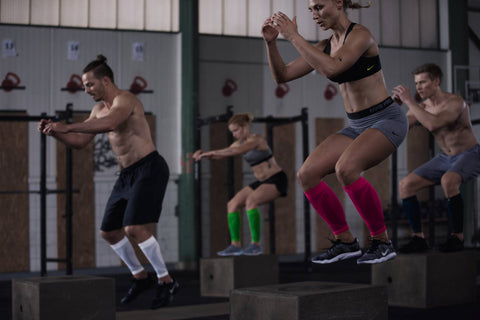Why stretch after a workout?
First, stretching makes for a great cool down. And second, stretching significantly boosts blood flow in and around muscle tissue, meaning your muscles get oxygen and nutrients at a faster rate. This is crucial because working out works by causing micro-tears to form in your muscle tissues which then heal into stronger, more resilient tissue. And the more nutrients and oxygen that are fed into these tears, the faster they heal and the faster your muscles recover.
On that note, let’s get into the best stretches to do.
Quad Stretch
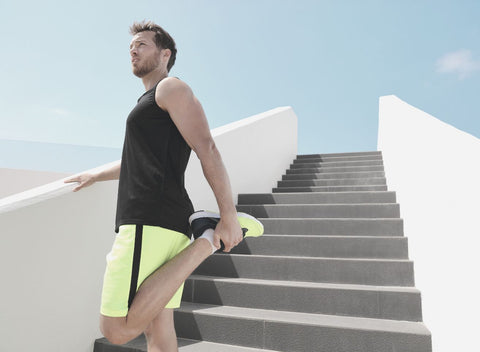
The Quad Stretch eases tension in your quadriceps, which are at the front of your thighs. These muscles are responsible for a lot of legwork and play important roles in squats and lunges.
- To start this stretch, stand upright near a wall.
- Bend your left leg up backwards toward your butt.
- Grab the ankle with your left hand and straighten your back.
- Make sure your body is properly aligned. Your knees should remain close together throughout the stretch, and your spine should be in a neutral posture.
- Hold for 20 seconds, then release.
- For a deeper stretch, pull your heel closer to your glutes.
- For a gentler stretch (or if you’re having trouble reaching your ankle), loop a towel or a yoga strap around your ankle.
Downward Facing Dog
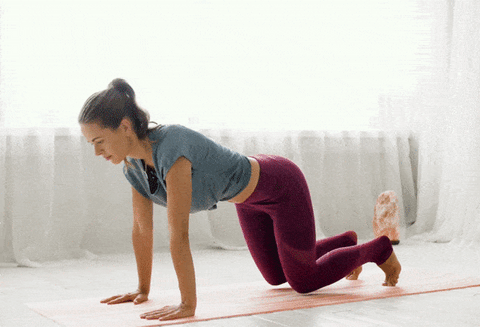
This yoga pose targets your hamstrings and calves which power exercises like hamstring curls, donkey kicks, and Romanian deadlifts.
- On a yoga mat, get on your hands and knees.
- Shift into a straight-arm plank.
- Push against your hands to straighten your legs and lift your hips.
- Let your head hang down and move your shoulder blades back in the direction of your hips.
- Gently lower your heels toward the floor, stopping if the stretch starts feeling uncomfortable or painful. DO NOT move your feet closer to your hands to touch your heels to the floor.
- Your spine should remain flat throughout the stretch. Arching your back, especially when your muscles are more prone to post-exercise stiffness, could lead to you pulling your hammies or glutes.
- Hold this pose for 10-15 seconds, then ease your knees toward the floor and relax.
You can also make this stretch more dynamic.
Butterfly Stretch

The Butterfly Stretch is a great stretch for sore legs. It targets a few muscle groups, including your inner thighs, hips, and lower back. These are key in performing side lunges and sumo squats.
- Sit on a yoga mat with your legs out in front of you.
- Bend your legs towards your groin so that the soles of your feet touch. It’s best to do this one leg at a time and gauge your comfort levels.
- Hold both feet with your hands and rest your elbows on your knees.
- While keeping your back straight, use your elbows to gently push your knees down toward the mat.
- You should feel a stretch throughout your hips and inner thighs.
- Hold for 20-30 seconds.
- Release and repeat 1-2 more times.
- DO NOT bounce your legs or force the stretch. This could lead to a pulled muscle.
Figure 4
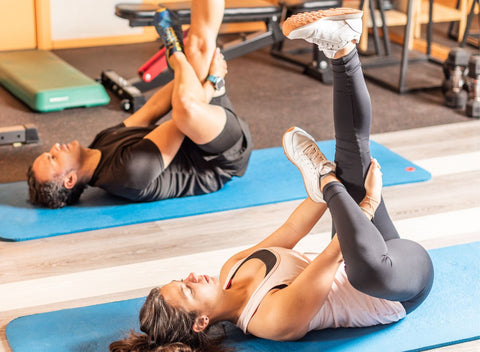
The figure 4 stretch eases tension in the glutes and hips.
- Lay on your back on a yoga mat.
- Cross your left ankle over your right knee.
- Bring your right knee toward your chest.
- Using your arms, gently pull your right leg closer to your chest, minding your comfort levels. Pause when you feel a stretch through your hips and glutes.
- Your spine should be flat throughout the stretch. As with downward dog, arching your back could lead to a pulled muscle.
- If you feel too much of a stretch in the hamstring of your right leg, bend that leg.
- Hold the stretch for 15 seconds, then release.
- Repeat for the other side.
- You can try a deeper stretch by further bending the knee of the leg you’re stretching.
Kneeling Hip Flexor Stretch
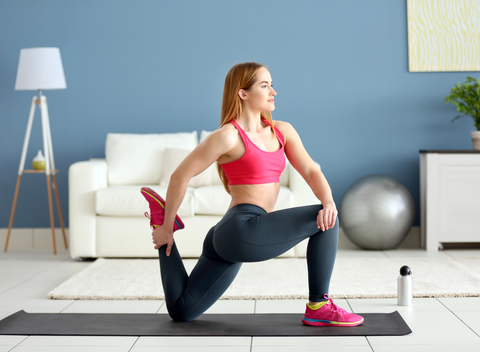
As the name might suggest, this stretch targets the hip flexors. These muscles are fundamental to any leg flexion movement.
- Kneel with both your knees on a yoga mat. You should be seated on the heels of your feet with the balls of your feet pressed against the mat.
- Press your palms into the mat in front of you and slightly bend your elbows to stop them from locking.
- Bring your left knee forward through the gap between your arms, placing your foot flat on the mat.
- Lift your hands off the mat and straighten your upper body. For additional support, you can place your hands on your left knee.
- Extend your right leg behind you to deepen the stretch. Your right knee, shin, and top of your right foot should be pressed into the mat.
- Lean forward gently into the stretch.
- Hold for 20-30 seconds and release by leaning back and returning to a kneeling position.
- Repeat for both legs.
- For a deeper stretch, you can also try bending your back leg at the knee and gently pulling it toward your glutes.
Seated Hip Rotation
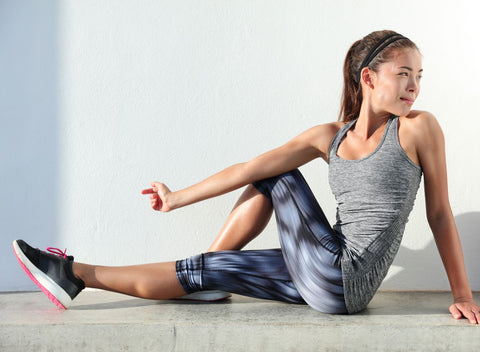
The ITB is notorious for tensing up after intense workouts. But this stretch can help keep it flexible.
- Sit on a yoga mat with your legs extended before you.
- Bend your right leg at the knee and cross it over your left leg, placing your foot flat on the floor. Your right ankle should be close to your left knee.
- Slowly turn your head and torso to the right, placing your right hand on the mat for support. Turn as far as is comfortable.
- You should feel a stretch through your outer hip, glute, and outer side of your leg.
- Hold for 30 seconds, then release. Repeat 2-3 more times.
- Repeat for the other side.
Does your Iliotibial band get tight often? Add these exercises to your leg day and core day workouts: Top 5 Exercises for ITB Syndrome
Beyond stretches
Sports Compression Calf Sleeves
Stretches after leg day are great for muscle recovery, but they shouldn’t be your only focus. For one, you need to properly rest between workouts to help you avoid more muscle pain and potential injuries. Remember, stiff muscles don't only make for a poor workout. They’re also much more prone to sprains.
And for two, your workout could benefit from compression sleeves. Our Sports Compression Thigh Sleeves and Sports Compression Calf Sleeves, for example, boost blood flow around those areas. Hence, they’ll add to the benefits of stretching and warming up your muscles, helping you avoid overstretching.
They also have a few added benefits like improved performance through muscle stimulation and increased venous return.
Learn more: #MaterialMatters: Types of medical grade compression and how it helps your recovery
To sum up
Leg day can be pretty brutal on your muscles, so it’s crucial to have a recovery system in place. And here, a good set of stretches, some compression sleeves, and sufficient rest go a long way.
Go to the gym often? Check out our range of performance gear.



